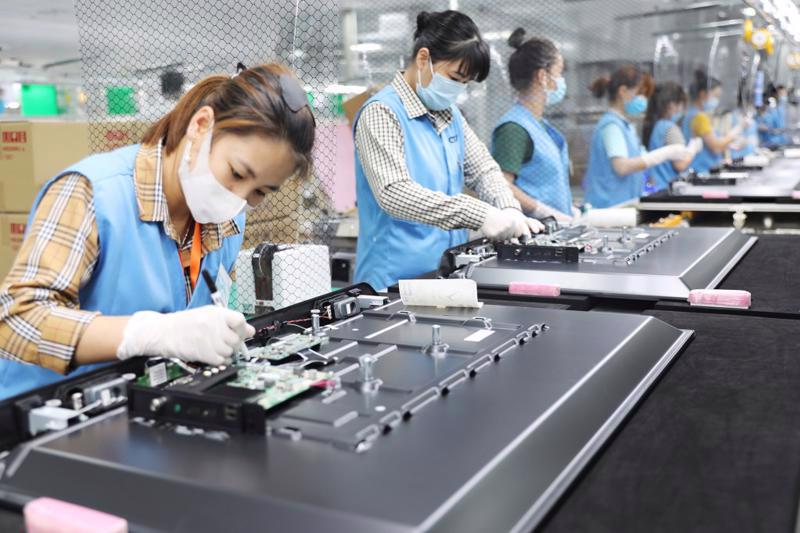Pivotal role of support industry
Attracting FDI offers Vietnam’s support industry a range of breakthrough opportunities to improve its position and standing.

Vietnam’s support industry, crucial in providing components, spare parts, and technical services to key sectors, is poised for a breakthrough, boosting its competitiveness and integrating more deeply into global value chains.
Amid the global shift in FDI and the diversification of global supply chains by major corporations, Vietnam remains a leading choice for international manufacturers. This presents not only a golden opportunity for the broader manufacturing sector but also significant growth potential for the country’s support industry.
Benefiting from FDI attraction
The strong inflow of FDI into the manufacturing and processing sector not only strengthens its central role in the economy but also fuels significant growth in the support industry. According to the Ministry of Planning and Investment, the manufacturing and processing sector continues to lead in FDI attraction, with total capital of $20.19 billion in the first eleven months of 2024, accounting for 64 per cent of all foreign investment flowing into Vietnam.
Notably, Vietnam’s support industry saw a series of major investments from large foreign enterprises in November, including two electronic component factories by Luxshare - ICT from China in north-central Nghe An province and an $80 million investment by Shunsin Technology Vietnam, part of Foxconn from Taiwan (China), in an electronic components plant in northern Bac Giang province.
Foreign giants investing in Vietnam’s support industry, such as LG Innotek, Samsung Electronics, Apple, LG, and Intel, not only strengthen Vietnam’s role in the global electronics supply chain but also create a ripple effect, boosting the competitiveness of the local support industry.
Additionally, Vietnam’s Index of Industrial Production (IIP) increased 8.4 per cent in the first eleven months of the year, with manufacturing and processing growing 9.7 per cent and contributing 8.5 percentage points to the overall rise. The export performance of several processed goods, including support industry products, also saw positive results. Electronic, computer, and component exports reached $65.22 billion, up 26.3 per cent year-on-year, while exports of phones, machinery, vehicles, and other items also saw notable growth.
According to the Vietnam Association of Supporting Industries (VASI), there are approximately 2,000 enterprises in Vietnam’s support industry, primarily engaged in producing supporting products for machinery, electronics, electricity, plastics, rubber, and chemicals. Over 300 of these are involved in multinational supply chains. This highlights the strong development within the industry, driven by the benefits of free trade agreements (FTAs) Vietnam has signed with major global powers, including the US, the EU, and Japan.
Regarding the electronics sector, which plays a pivotal role in the support industry, data from the General Department of Vietnam Customs shows that the export of computers, electronics, and components rose 26.1 per cent to $12.79 billion in the first eleven months of 2024, while machinery, equipment, and spare parts grew 21.7 per cent to $8.08 billion. These two product categories accounted for double the export value of the third-largest category - machinery, equipment, tools, and spare parts. Recognizing this, the government has identified electronics as a key industry in the modern economy, with a significant impact on other sectors.
Ms. Do Thi Thuy Huong, Member of the Executive Committee of the Vietnam Electronics Enterprises Association (VEIA), noted that Vietnamese companies can produce many mid-range and high-end accessories, further solidifying their position in the global electronics supply chain. However, she emphasized that local electronics companies still focus primarily on processing and assembly, neglecting areas like design, research and development (R&D), and distribution. To add more value, these companies need to build stronger supply chains and diversify their operations, which would also stimulate growth in other supporting industries.
Dr. Mac Quoc Anh, Vice President and General Secretary of the Hanoi Association of Small and Medium Enterprises (HANOISME), said candidly that the support industry for the electronics sector remains relatively underdeveloped, with only 36 per cent of enterprises involved in the supply chain. The electronics industry, especially in technology, is rapidly evolving, with new products being launched every 3-6 months. In addition to hardware, software products are continuously updated by large multinational companies to keep pace with consumer trends.
The Ministry of Industry and Trade has noted that the rate of digital transformation at Vietnamese electronics enterprises is currently quite low, with few willing to invest in digitalization. As a result, the support industry for electronics is in need of significant breakthroughs. Domestic enterprises must integrate more deeply into global value chains, establish a robust support industry ecosystem, and collaborate with leading international tech corporations.
Experts believe that Vietnam’s support industry market is valued in the hundreds of billions of dollars. Fostering links between local support industry businesses and foreign enterprises therefore presents a key opportunity for Vietnamese companies to enhance their production capacity, capture a larger share of the domestic market, and successfully integrate into the global supply chain. Vietnam’s support industry is progressively advancing its organizational production capabilities, with many companies now acting as suppliers for multinational corporations and participating in the global production and supply network. This growth has played a significant role in attracting major international corporations, leading to the expansion of factories and the establishment of R&D centers around Vietnam.
Boosting localization
Resolution No. 115/NQ-CP, dated August 6, 2020, which outlines the development of the support industry from 2020 to 2030, sets a target of Vietnam meeting 45 per cent of domestic demand for components and spare parts by 2025 and 65 per cent by 2030. In sectors such as textiles, garments, and leather, the goal is to achieve 65 per cent local supply for textiles and 75-80 per cent for leather by 2025. However, experts point out that the localization rate in certain support industries is still low, meeting just 10 per cent of domestic demand for components, while Vietnam continues to import components costing billions of dollars each year to support local production.
Vietnam’s stable policies and participation in FTAs have created favorable conditions, attracting many international corporations to look for partners in the country. This presents a significant opportunity for businesses in the support industry to grow and expand their market share. However, these opportunities also come with challenges, as companies must comply with stringent production standards, including infrastructure and quality management processes.
A representative from the An Mi Tools Co. said US and European aviation companies are increasingly interested in sourcing equipment suppliers in Vietnam. However, entering the production chain is difficult, costly, and risky in the initial stage, as businesses are yet to fully evaluate factors such as order stability and size.
Thus, businesses need a long-term development strategy that includes training skilled technicians and engineers so they gain a deep understanding of international standards, as well as fostering closer collaboration within the global supply chain. Furthermore, companies must digitize and optimize their management systems to ensure consistency, transparency, and efficiency throughout the production process.
Mr. Phan Dang Tuat, Chairman of VASI, noted that the support industry is vital in the development of the country’s manufacturing and processing sector. However, current government support remains limited, and the sector has yet to realize its full potential. To remain competitive with other countries in the region and globally, there needs to stronger collaboration between domestic and foreign companies, along with more effective government policies.
Moreover, government support in creating a favorable investment environment and facilitating business networking and partnerships will be key in helping Vietnam’s support industry thrive and dominate international markets in the near future. By harnessing opportunities, fostering innovation, and strengthening collaboration, businesses can position themselves for success in the evolving global market.







![[Interactive]: Economic overview - April 2025](https://media.vneconomy.vn/400x225/images/upload/2025/05/06/5a245778-67b1-4874-a8dc-21f8cfed62a6.png)